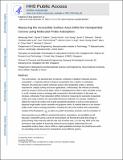Measuring the Accessible Surface Area within the Nanoparticle Corona using Molecular Probe Adsorption
Author(s)
Park, Minkyung; Salem, Daniel P; Parviz, Dorsa; Gong, Xun; Silmore, Kevin S; Lew, Tedrick Thomas Salim; Khong, Duc Thinh; Ang, Mervin Chun-Yi; Kwak, Seon-Yeong; Chan-Park, Mary B; Strano, Michael S; ... Show more Show less
DownloadAccepted version (1.330Mb)
Open Access Policy
Open Access Policy
Creative Commons Attribution-Noncommercial-Share Alike
Terms of use
Metadata
Show full item recordAbstract
Copyright © 2019 American Chemical Society. The corona phase - the adsorbed layer of polymer, surfactant, or stabilizer molecules around a nanoparticle - is typically utilized to disperse nanoparticles into a solution or solid phase. However, this phase also controls molecular access to the nanoparticle surface, a property important for catalytic activity and sensor applications. Unfortunately, few methods can directly probe the structure of this corona phase, which is subcategorized as either a hard, immobile corona or a soft, transient corona in exchange with components in the bulk solution. In this work, we introduce a molecular probe adsorption (MPA) method for measuring the accessible nanoparticle surface area using a titration of a quenchable fluorescent molecule. For example, riboflavin is utilized to measure the surface area of gold nanoparticle standards, as well as corona phases on dispersed single-walled carbon nanotubes and graphene sheets. A material balance on the titration yields certain surface coverage parameters, including the ratio of the surface area to dissociation constant of the fluorophore, q/KD, as well as KD itself. Uncertainty, precision, and the correlation of these parameters across different experimental systems, preparations, and modalities are all discussed. Using MPA across a series of corona phases, we find that the Gibbs free energy of probe binding scales inversely with the cube root of surface area, q. In this way, MPA is the only technique to date capable of discerning critical structure-property relationships for such nanoparticle surface phases. Hence, MPA is a rapid quantitative technique that should prove useful for elucidating corona structure for nanoparticles across different systems.
Date issued
2019Department
Massachusetts Institute of Technology. Department of Chemical Engineering; Singapore-MIT Alliance in Research and Technology (SMART)Journal
Nano Letters
Publisher
American Chemical Society (ACS)